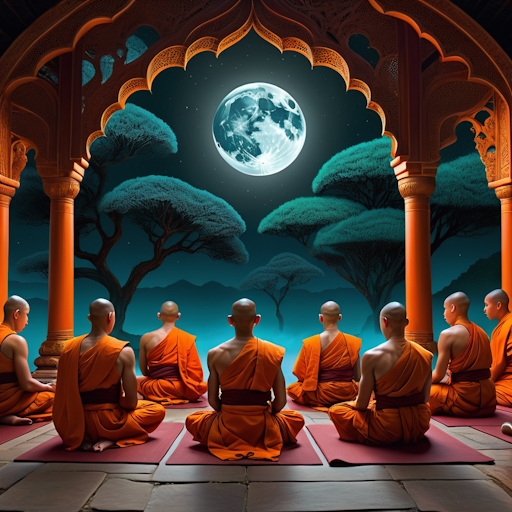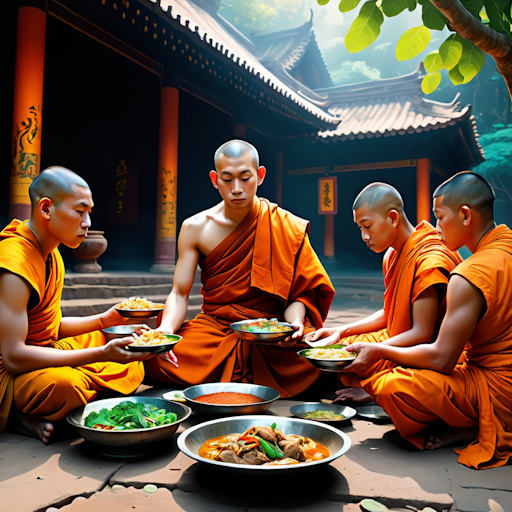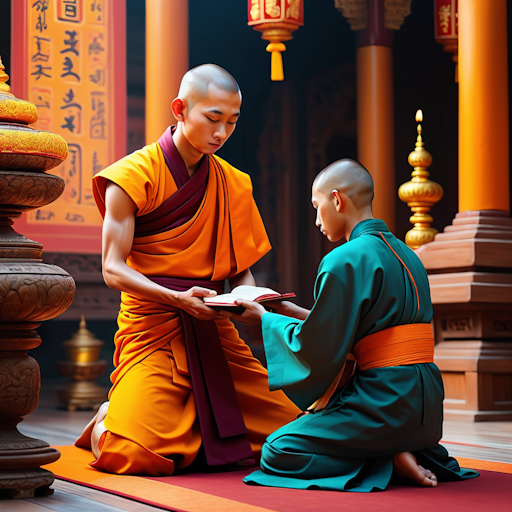Buddhism, with its rich spiritual tradition and commitment to inner transformation, has long been associated with the serene and disciplined lives of Buddhist monks and nuns. The monastery, the cornerstone of Buddhist monastic life, provides an environment where individuals dedicate themselves to meditation, study, and ethical living. In this article, we’ll take a deep dive into the daily routines of Buddhist monks and nuns, the significance of the monastic community, and the process of ordination.
Daily Routines of Buddhist Monks and Nuns
Buddhist monastic life is characterized by a structured daily routine that emphasizes spiritual practice, self-discipline, and simplicity. Here’s a glimpse into the typical daily schedule of Buddhist monks and nuns:
Pre-Dawn Meditation:
The day begins with meditation in the early hours before dawn. This session, known as morning meditation or “Amgak,” allows practitioners to cultivate inner peace, clarity, and focus.

Alms Round (Pindapata):
After meditation, monks and nuns participate in the alms round, a daily ritual where they walk through the nearby community to receive food offerings from laypeople. This practice emphasizes humility and the mutual support between monastics and the laity.
Study and Meditation:
The core of monastic life involves the study of Buddhist scriptures, philosophy, and meditation techniques. This may occupy a significant portion of the day. Monks and nuns engage in solitary meditation as well as group study sessions under the guidance of experienced teachers.
Chores and Maintenance:
Monastic life also involves practical responsibilities. Monks and nuns are responsible for the maintenance of the monastery, which includes cleaning, gardening, and repairs. These tasks serve as opportunities for mindfulness and humility.
Midday Meal (Dana):
Laypeople offer the midday meal to the monastic community. This practice, called “Dana,” is an expression of generosity and support for the monks and nuns. The meal is typically simple and vegetarian.

Rest and Contemplation:
After the meal, there is a period of rest and contemplation. This allows monastics to digest their food and reflect on their practice.
Evening Meditation:
The day concludes with another meditation session. This evening meditation, or “Yebul,” is an opportunity to review the day’s activities and cultivate inner peace before retiring to their quarters for rest.
The Significance of the Monastic Community
The monastic community, or Sangha, holds a special place in Buddhist practice. It is a vital component of the Three Jewels, which include the Buddha (the enlightened one), the Dharma (the teachings), and the Sangha (the community). The Sangha is significant for several reasons:
Spiritual Support: The monastic community provides spiritual support and guidance to both lay practitioners and novice monastics. The teachings and guidance of experienced monks and nuns help individuals deepen their practice.
Preservation of the Dharma: Monastics play a pivotal role in preserving and propagating the Buddha’s teachings. Through their study, memorization, and transmission of texts, they ensure the continuity of the Dharma.
Living Examples: Monks and nuns serve as living examples of a simple and ethical way of life. Their commitment to minimalism, mindfulness, and ethical conduct inspires others to follow the Buddhist path.
Mutual Support: The Sangha operates as a supportive network. Monks and nuns rely on each other for guidance and encouragement on their spiritual journey.
The Process of Ordination
Becoming a Buddhist monk or nun involves a process known as ordination. This process varies in different Buddhist traditions, but it generally follows a similar framework. Here’s an overview of the ordination process:
Novice Ordination: Aspiring monastics typically begin as novices, known as Samanera (in Theravada) or Tokudo (in Zen). Novices live under the guidance of senior monastics, study Buddhist texts, and participate in the daily routines of the monastery.
Full Ordination: To attain full monastic status, individuals undergo a formal ordination ceremony, also known as “Upasampada.” During this ritual, the candidate takes vows, receives a new monastic name, and joins the monastic community as a fully ordained monk (Bhikkhu) or nun (Bhikkhuni).

Vows and Precepts: Monastic ordination involves taking a set of precepts or vows, often referred to as Vinaya. These precepts outline rules and guidelines for ethical conduct, covering areas such as abstaining from killing, stealing, and sexual misconduct.
Lifetime Commitment: Ordination as a monk or nun is considered a lifelong commitment. While individuals can choose to disrobe and return to lay life, the decision to ordain is typically made with great seriousness.
Mentorship: Throughout their monastic journey, individuals receive mentorship and guidance from experienced monastics who assist them in their practice and understanding of the Dharma.
Conclusion
Buddhist monastic life offers a profound opportunity for spiritual growth, inner transformation, and the pursuit of enlightenment. Through their daily routines, the significance of the monastic community, and the process of ordination, monks and nuns exemplify a path of simplicity, mindfulness, and ethical living that inspires and guides countless individuals on their own spiritual journeys.
The monastic community remains an integral part of Buddhism, embodying the timeless teachings of the Buddha and preserving the wisdom of the Dharma for future generations.